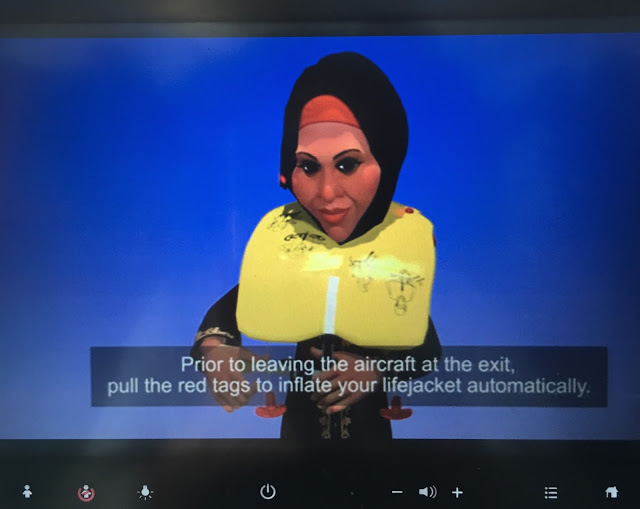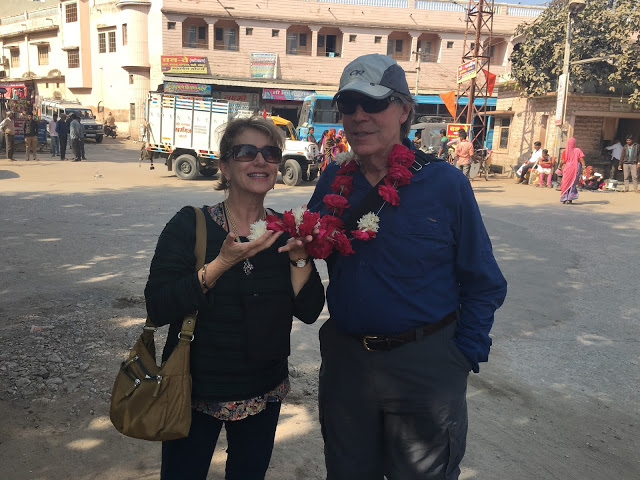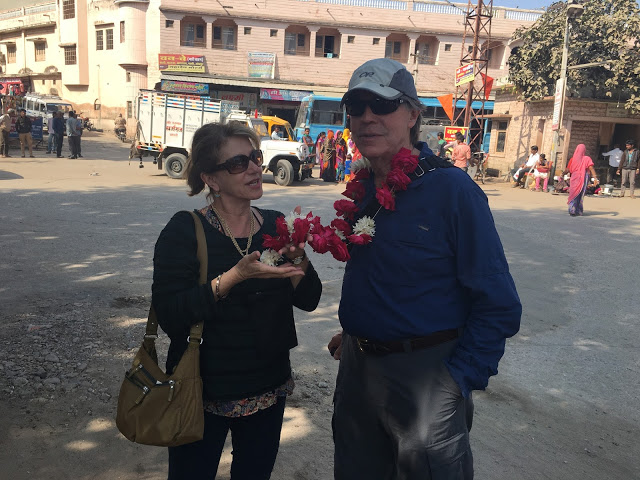

Devi – goddess: These are tough ladies as you can see from their multiple arms, fearsome blue faces, devouring ways and ability to dispense with demons and then wear their heads as trophies. The chasm between monotheism and Hinduism looms large, especially in the goddess role. Q. Do people actually believe this stuff? Maybe it’s sensible to have a God for every occasion (good god, bad god, silly god, ferocious god, ineffectual god, meditating navel-gazing god) so you don’t have to spend your life wondering why only one God makes bad things happen to good people.

Even trees get in the act. They’re alive and an important part of the chain of life; why not? I ask why people ring a bell when they enter a temple. It’s to announce to the god that you are there and he/she/it should wake up from their nap. Talk about bringing god down to earth! Love it…
My personal favorite — Ganesh – the elephant boy. I made the mistake of referring to him as Mr. Ganesh. The guide I was with corrected me soberly “you mean Lord Ganesh.” He may look like a roll-poly created by kindergarteners, but I am reminded that behind the colorful silliness, this is serious business. And he is everywhere. Elaborately painted and surrounded by flowers and offerings of coconut and fruit, his effigy is on every street corner. You just can’t get farther from the sober suffering of Christian saints.
A mound of marigolds ready to purchase as an offering for whatever gods are within. The intensity of the yellows, golds, orange and sienna is non-stop. There’s quite an industry in the growing, preparation, assembly, transport and sale of flower garlands everywhere.
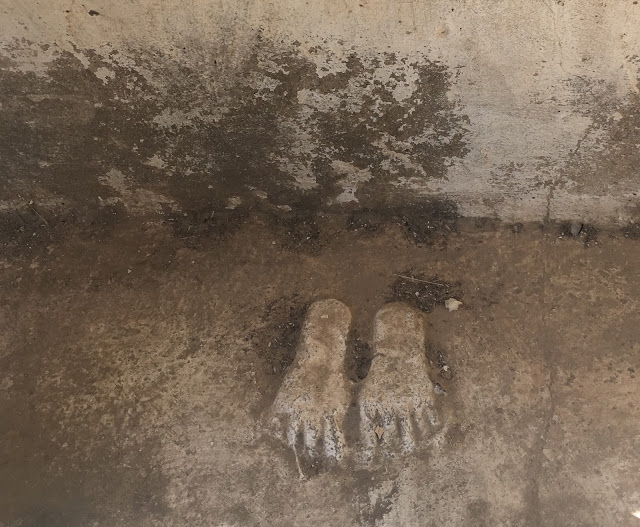
Footprints representing Lakshmi – wife of Vishnu, and goddess of wealth and good fortune, often found on the threshold of a house and bring the occupants good luck.
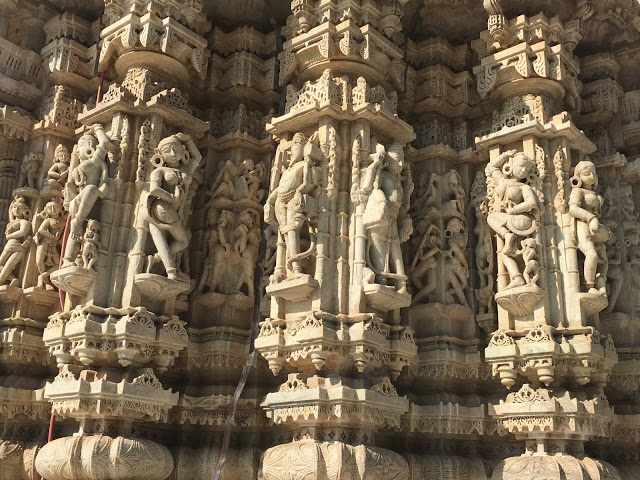
The exquisite carvings of the Jain Temple of Ranakpur, built in 1439 and one of the 5 most important pilgrimage sites of Jainism – an ancient religion practiced by a remnant 5 million in India – once much more prevalent. A religion of non-violence and meditation in which the nuns wear mouth coverings so that they do not inadvertently swallow even a bug. But for reasons that no one can explain, the carvings often include sex acts between multiple partners and animals. They certainly show off hundreds of voluptuous Aspara — celestial dancers — present in all Hindu origin myths. Ah, to be a celestial dancer! Modern Jains are evidently extremely successful businessmen and money lenders. Many villages in Rajasthan have one or two extravagant houses among the shacks as country houses for city Jains so they can retreat to their humble origins a few times a year.
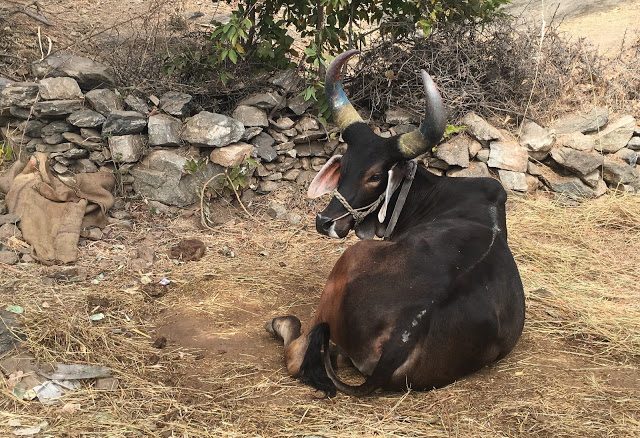
Cows. Yes, they really are everywhere. Gives new meaning to free-range, as they are often standing in front of you as you walk or drive. Riots are started over rumors that Muslims are slaughtering cows. I ask what happens if a car inadvertently hits one – it’s amazing that they aren’t struck more often – and the answer is that you just have to pay it forward (in addition to paying the owner) by being nicer to cows, or any living creature. This cow has had her horns gaily painted. I saw a cow with bright red spots painted for some ceremony, or just because someone felt like making that cow feel special. In the same village, I also saw a dead cow, just lying in the street, a small child checking it out. Looked like it had been there for some time…
Following are “signs” that got my attention:

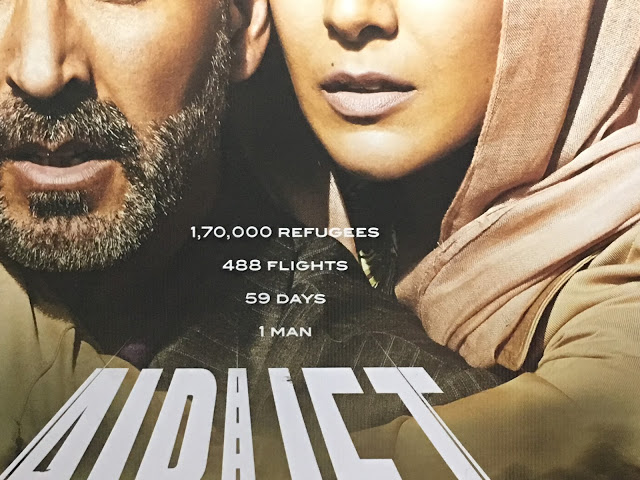
 PC invades. Any differently abled guests would have had a very hard time negotiating the many stairs at Devi Garh.
PC invades. Any differently abled guests would have had a very hard time negotiating the many stairs at Devi Garh. 




 View of the “blue” city of Jodhpur from the heights of the Mehrangarh Fort, founded in 1460 and one of the largest forts in India. It sits at 410 feet above the city, is entered through one of seven gates, and consists of many palaces and an excellent museum of armory, palanquins, elephant howdahs, and delicately carved, mirrored and decorated rooms. It is packed with local tourists on a Sunday afternoon. We are about the only gringos in a crowd of several thousand.
View of the “blue” city of Jodhpur from the heights of the Mehrangarh Fort, founded in 1460 and one of the largest forts in India. It sits at 410 feet above the city, is entered through one of seven gates, and consists of many palaces and an excellent museum of armory, palanquins, elephant howdahs, and delicately carved, mirrored and decorated rooms. It is packed with local tourists on a Sunday afternoon. We are about the only gringos in a crowd of several thousand.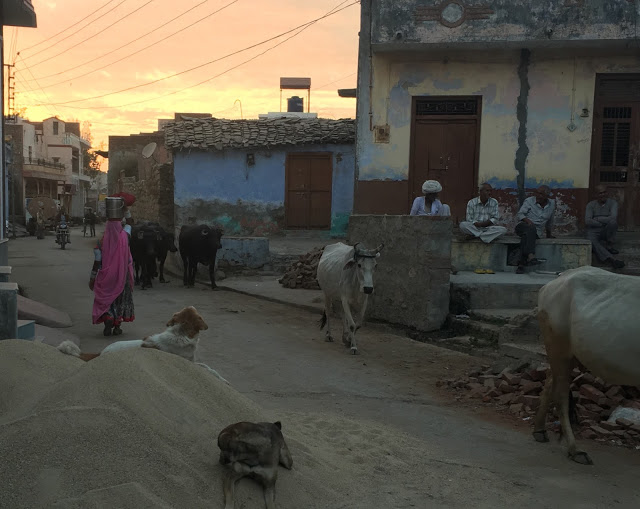 Narlai: Village life at sunset. Monkeys jump in the trees, kids fly kites from rooftops in preparation for the annual kite-flying festival, and green parrots squawk and swoop. Temple bells ring and a muezzin calls the faithful (about 20% of most villages) to prayer. Pigs root in the garbage – undeterred by the prospect of becoming bacon as neither Hindu nor Muslim will eat them.
Narlai: Village life at sunset. Monkeys jump in the trees, kids fly kites from rooftops in preparation for the annual kite-flying festival, and green parrots squawk and swoop. Temple bells ring and a muezzin calls the faithful (about 20% of most villages) to prayer. Pigs root in the garbage – undeterred by the prospect of becoming bacon as neither Hindu nor Muslim will eat them. Family history captured in portraits on the walls of Rawla Narlai, still owned by the royal family of Jodhpur.
Family history captured in portraits on the walls of Rawla Narlai, still owned by the royal family of Jodhpur. The botanical gardens on the outskirts of Jodhpur have seen better days; garbage floats in the canals and the plants are not kept up. But the temples and architecture are exquisite. Close your eyes and go back centuries. Here in the 21st century, families stroll, peddlers sell, the occasional beggar begs, temple bells ring, kids hang out, funeral pyres occasionally burn. Funerals need the four elements: water, wind, fire and earth. Ashes are taken to the holy Ganges. The service is over when the eldest son takes a club and cracks open the skull of the parent to release the soul. I wonder what Freud would have to say…
The botanical gardens on the outskirts of Jodhpur have seen better days; garbage floats in the canals and the plants are not kept up. But the temples and architecture are exquisite. Close your eyes and go back centuries. Here in the 21st century, families stroll, peddlers sell, the occasional beggar begs, temple bells ring, kids hang out, funeral pyres occasionally burn. Funerals need the four elements: water, wind, fire and earth. Ashes are taken to the holy Ganges. The service is over when the eldest son takes a club and cracks open the skull of the parent to release the soul. I wonder what Freud would have to say…





